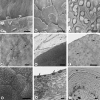Evolution of the structure and function of the vertebrate tongue
- PMID: 12171472
- PMCID: PMC1570891
- DOI: 10.1046/j.1469-7580.2002.00073.x
Evolution of the structure and function of the vertebrate tongue
Abstract
Studies of the comparative morphology of the tongues of living vertebrates have revealed how variations in the morphology and function of the organ might be related to evolutional events. The tongue, which plays a very important role in food intake by vertebrates, exhibits significant morphological variations that appear to represent adaptation to the current environmental conditions of each respective habitat. This review examines the fundamental importance of morphology in the evolution of the vertebrate tongue, focusing on the origin of the tongue and on the relationship between morphology and environmental conditions. Tongues of various extant vertebrates, including those of amphibians, reptiles, birds and mammals, were analysed in terms of gross anatomy and microanatomy by light microscopy and by scanning and transmission electron microscopy. Comparisons of tongue morphology revealed a relationship between changes in the appearance of the tongue and changes in habitat, from a freshwater environment to a terrestrial environment, as well as a relationship between the extent of keratinization of the lingual epithelium and the transition from a moist or wet environment to a dry environment. The lingual epithelium of amphibians is devoid of keratinization while that of reptilians is keratinized to different extents. Reptiles live in a variety of habitats, from seawater to regions of high temperature and very high or very low humidity. Keratinization of the lingual epithelium is considered to have been acquired concomitantly with the evolution of amniotes. The variations in the extent of keratinization of the lingual epithelium, which is observed between various amniotes, appear to be secondary, reflecting the environmental conditions of different species.
Figures






Similar articles
-
Function-related morphological characteristics and specialized structures of the avian tongue.Ann Anat. 2014 May;196(2-3):75-87. doi: 10.1016/j.aanat.2013.09.005. Epub 2013 Oct 24. Ann Anat. 2014. PMID: 24219998 Review.
-
Fine structure of the dorsal lingual epithelium of the juvenile hawksbill turtle, Eretmochelys imbricata bissa.Anat Rec. 1996 Apr;244(4):437-43. doi: 10.1002/(SICI)1097-0185(199604)244:4<437::AID-AR2>3.0.CO;2-S. Anat Rec. 1996. PMID: 8694279
-
Ultrastructural study of the keratinization of the dorsal epithelium of the tongue of Middendorff's bean goose, Anser fabalis middendorffii (Anseres, Antidae).Anat Rec. 1997 Feb;247(2):149-63. doi: 10.1002/(SICI)1097-0185(199702)247:2<149::AID-AR1>3.0.CO;2-T. Anat Rec. 1997. PMID: 9025994
-
Ultrastructural study of the dorsal lingual epithelium of the soft-shell turtle, Trionyx cartilagineus (Chelonia, Trionychidae).Anat Rec. 1996 Nov;246(3):305-16. doi: 10.1002/(SICI)1097-0185(199611)246:3<305::AID-AR1>3.0.CO;2-X. Anat Rec. 1996. PMID: 8915452
-
Comparative morphology of the gallbladder and biliary tract in vertebrates: variation in structure, homology in function and gallstones.Microsc Res Tech. 1997 Sep 15;38(6):571-97. doi: 10.1002/(SICI)1097-0029(19970915)38:6<571::AID-JEMT3>3.0.CO;2-I. Microsc Res Tech. 1997. PMID: 9330347 Review.
Cited by
-
Separating the effects of prey size and speed on the kinematics of prey capture in the omnivorous lizard Gerrhosaurus major.J Comp Physiol A Neuroethol Sens Neural Behav Physiol. 2010 Jul;196(7):491-9. doi: 10.1007/s00359-010-0537-1. Epub 2010 Jun 3. J Comp Physiol A Neuroethol Sens Neural Behav Physiol. 2010. PMID: 20521149
-
Transdifferentiation of tongue muscle cells into cancer-associated fibroblasts in response to tongue squamous cell carcinoma.Nat Commun. 2025 Jul 22;16(1):6753. doi: 10.1038/s41467-025-61951-3. Nat Commun. 2025. PMID: 40695868 Free PMC article.
-
Structural and ultrastructural features of the agouti tongue (Dasyprocta aguti Linnaeus, 1766).J Anat. 2013 Aug;223(2):152-8. doi: 10.1111/joa.12065. Epub 2013 May 23. J Anat. 2013. PMID: 23701183 Free PMC article.
-
A TGFβ-Smad4-Fgf6 signaling cascade controls myogenic differentiation and myoblast fusion during tongue development.Development. 2012 May;139(9):1640-50. doi: 10.1242/dev.076653. Epub 2012 Mar 21. Development. 2012. PMID: 22438570 Free PMC article.
-
Mandible and Tongue Development.Curr Top Dev Biol. 2015;115:31-58. doi: 10.1016/bs.ctdb.2015.07.023. Epub 2015 Oct 1. Curr Top Dev Biol. 2015. PMID: 26589920 Free PMC article. Review.
References
-
- Avery JK. Baltimore: Williams & Wilkins; 1987. Oral Development and Histology.
-
- Baratz RS, Farbman AI. Morphogenesis of rat lingual filiform papillae. Am. J. Anat. 1975;143:283–302. - PubMed
-
- Beisser CJ, Weisgram J, Hilgers H, Splechtna H. Fine structure of the dorsal lingual epithelium of Trachemys scripta (Chelonia: Emydidae) Anat. rec. 1998;250:127–135. - PubMed
-
- Beisser CJ, Weisgram J, Splechtna H. Dorsal lingual epithelium of Platemys pallidipectoris. J. Morph. 1995;226:267–276. - PubMed
Publication types
MeSH terms
LinkOut - more resources
Full Text Sources

